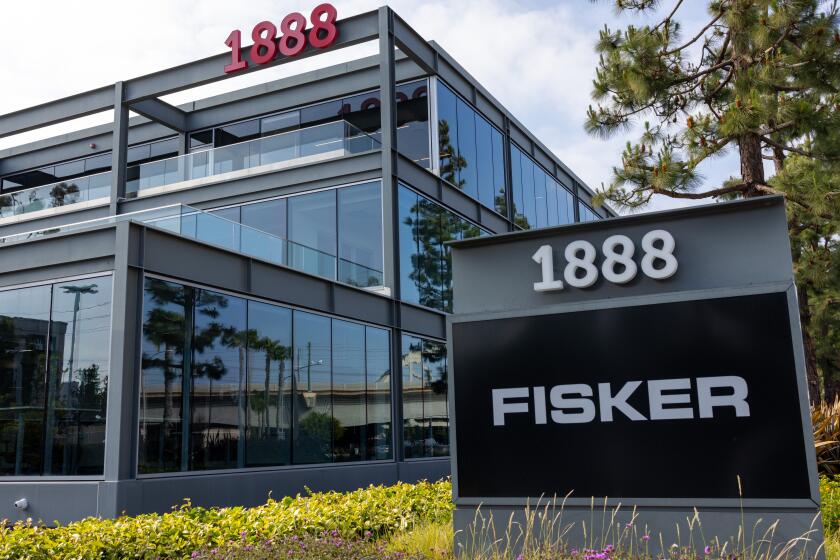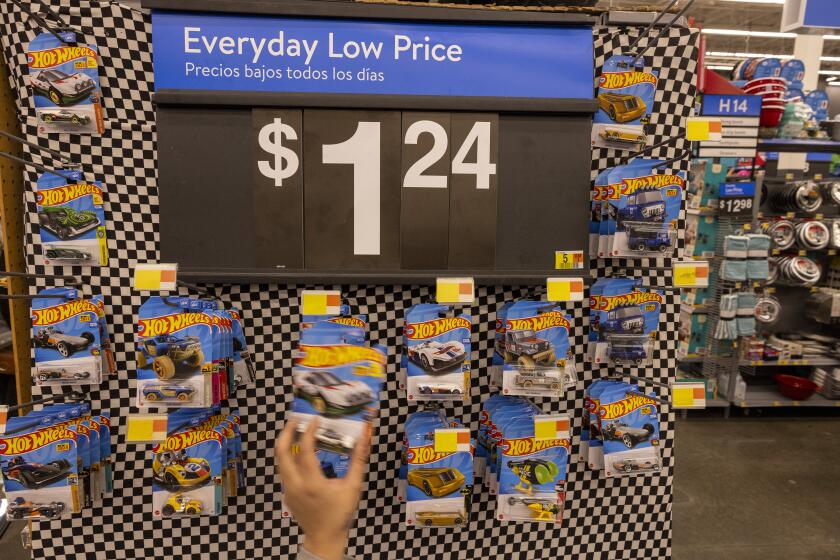The Waters Are Crowded for Surfboard Makers
Seven months ago, the abrupt closure of Clark Foam in Laguna Niguel caught the surf industry in its undertow. But as the peak selling season swells, there is no shortage of surfboards.
“We were all frantic at first: What are we going to do for foam?” said Bill Bahne, president of fin maker Fins Unlimited in Encinitas, who represents surfboard makers on the Surf Industry Manufacturers Assn. board.
“But in reality,” he said, “everybody had plenty of time to get alternative supplies for the foam.”
He was referring to Gordon “Grubby” Clark’s surprise decision Dec. 5 to close his factory after 44 years in business. His company made the polyurethane foam cores for two-thirds of the surfboards made in the United States, so his closure prompted fears of shortages.
The upset was felt throughout an industry populated by a mishmash of businesses from backyard shapers to major players such as Channel Islands Surfboards in Santa Barbara, which churns out as many as 2,000 boards in a month.
The process of making most surfboards starts with polyurethane foam that is molded into “blanks,” which are roughly in the form of a surfboard. Shapers sculpt the blanks and glassers apply a fiberglass shell over the foam core.
In the last few weeks, surfboard sales have rebounded in Southland surf shops after a weak early 2006. Over the holiday weekend, Becker Surf & Sport’s surfboard sales were “almost out of control,” said Dave Hollander, owner of the five-store chain, based in Hermosa Beach.
“I’m selling two at a time,” he said Monday.
Retail sales of surfboards totaled $200 million nationwide in 2003, the most recent number available, according to the Surf Industry Manufacturers Assn.
Immediately after Clark’s closure, some production was disrupted as board makers scrambled for blanks. Certainly some companies took a hit. Alternative suppliers quickly surfaced, however, eager to scoop up some of Clark’s business.
What surfboard sellers say they needed most in the first half of 2006 was more buyers. Sales fell off for a variety of reasons.
Some shoppers stocked up on boards in December when the first waves of worry washed over the industry, pushing up prices and driving down demand in subsequent months. In addition, with so many foam cores now coming in from new sources, some shoppers have questioned their quality, industry insiders said.
With the cost of a surfboard typically about 20% higher than when Clark Foam closed, not everyone wants to shell out the extra cash, given concerns about rising interest rates and gasoline prices, Bahne said.
Most surfboards now cost about $400 to almost $1,100, he said.
Some surfers are just buying ding-repair kits and hanging on to their old boards.
“We’ve got a little demand hangover,” said “T.K.” Brimer, owner of the Frog House board shop in Newport Beach, who acknowledges that he was one who “panicked.”
Initially, Brimer bought more than 200 boards from a local supplier for his small shop. At first they sold quickly. Then he decided to hedge his bets by ordering 80 more from two Australian manufacturers.
“When I ordered those things, I’m thinking I’m the smartest man in the world,” Brimer said. “Now here’s the reality: I don’t know where I’m going to store the things. They’re coming out of my ears.”
Sales at Channel Islands Surfboards -- which announced last week that it was being purchased by Burton Snowboards -- dropped 30% this year compared with last, General Manager Scott Anderson said. Channel Islands is the nation’s largest seller of boards made with polyurethane cores.
But Anderson, too, says sales have picked up in recent weeks, as both the surf and temperatures rose.
Most surfboards sold in the U.S. have a polyurethane foam core, but there’s a growing acceptance within the industry of epoxy boards -- made with polystyrene foam and epoxy resin and mass-produced in Asia.
Surftech, a Santa Cruz company that uses the polystyrene foam and resin technique, was recently named board builder of the year by the surf industry trade group.
Surftech’s revenue is up “significantly” over last year, said Fritz Bensusan, the company’s national sales manager.
That’s partly because Clark Foam’s closure narrowed the price gap between the typical polyurethane-core surfboard and the boards made by Surftech, which generally are more expensive.
Others also got a boost from the shake-up.
For example, Bahne of Fins Unlimited helped launch Pacifica Foam in Oceanside to make polyurethane blanks.
“Before Dec. 5,” he said, “I would never have thought of making foam.”
Just Foam of San Clemente expanded its California work space, opened a chemical manufacturing plant in Nevada, started making foam in Australia and is selling blanks in Japan, owner Scott Saunders said. The company makes 250 foam cores a day, he said, instead of the 25 it was producing seven months ago.
Still, he said, “I wish Clark hadn’t have gone out of business.... It put a lot of pressure on me, literally. My back’s been locked up for I don’t know how many months.”
And then there’s the problem of working when you could be surfing. Just ask Gary Linden, plant manager at Walker Foam Inc. in Wilmington, where sales are 10 times what they were in November.
“I’m missing a lot of the surf, which has been hard to take for me,” he said.
“I haven’t worked this hard in my entire life.”
More to Read
Inside the business of entertainment
The Wide Shot brings you news, analysis and insights on everything from streaming wars to production — and what it all means for the future.
You may occasionally receive promotional content from the Los Angeles Times.









